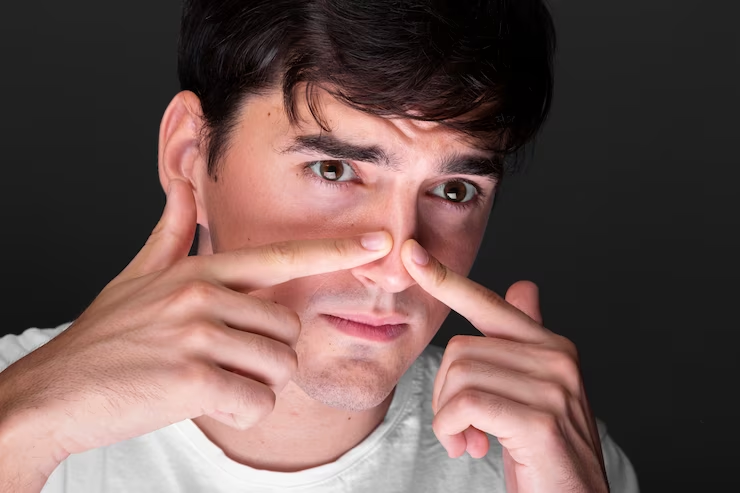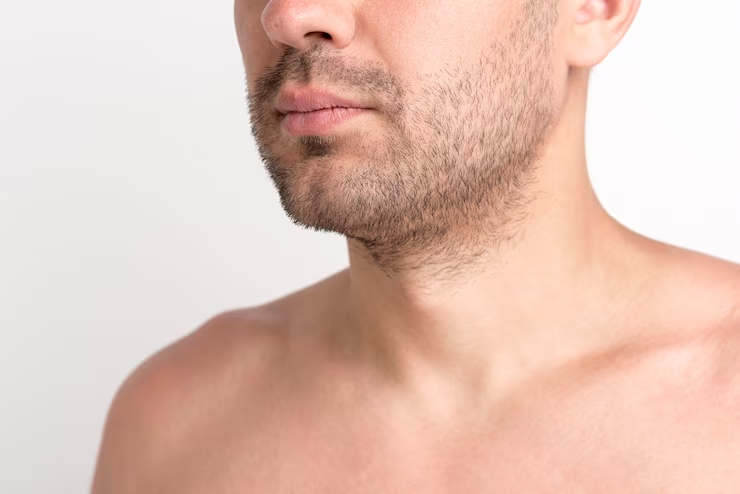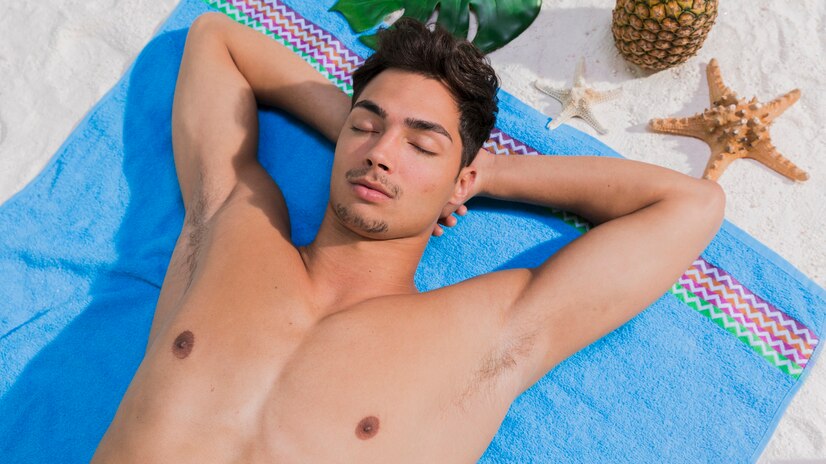
The nose is a prominent facial feature and is often the first thing people notice when looking at you. Pimples on the nose are unsightly and can also be painful and embarrassing. Taking care of them is important because it can lead to scarring or permanent discoloration if left untreated.
Nose pimples are caused by sebum and bacteria, which combine to form a plug. This can happen anywhere on your face, but it's more likely to occur in the oily areas of your skin, such as your nose.
While there's no way to prevent getting an occasional pimple completely, there are some steps you can take to reduce the chances of developing acne or other types of acne-related conditions like blackheads or whiteheads:
We want you to feel confident in your skin–so we'll be sharing practical ways how to get rid of pimples on your nose and how you can use your lifestyle choices to help prevent them from forming in the first place. So, let's dive in!
What Causes Pimples on the Nose?
Clogged pores
Blocked pores are a major cause of pimples on the nose. Pimples form when your pores become clogged with oil and dead skin cells, which causes bacteria to grow. This can lead to inflammation, redness, and pus-filled spots on your skin.
This is especially likely because of the extra oil build-up in your pores if you have oily skin. To prevent blocked pores and pimples from forming on the nose, try using an exfoliating scrub that contains salicylic acid or glycolic acid every day after cleansing.
Ingrown hairs
The hair follicles on your nose are usually pretty shallow, which means that when you start to shave or wax your nose, the hair can curl back into the follicle and cause an infection.
If you get razor bumps or ingrown hairs on your nose, try shaving toward hair growth instead of against it. Also, ensure you use new razor blades every time you shave so they don't have time to dull.
Nasal vestibulitis
Nasal vestibulitis is caused by an inflammation of the nasal vestibulum, which is the area of your nostrils closest to your eyes. The exact cause of this inflammation varies from person to person, but it's usually due to an infection inside your nostrils.
Symptoms include painful swelling in your nostrils and a burning sensation when you breathe through them. You may also experience other symptoms like sneezing, crusting around your nostrils, redness, and discharge.
You may need treatments such as oral antibiotics or antibiotic ointments to reduce the inflammation.
Nasal furuncles
Nasal furuncles are small, red bumps that may appear on the tip of your nose. They're caused by bacteria trapped inside hair follicles—a tiny channel extending from the root of each hair. These furuncles can be painful and cause a burning sensation to radiate across your face.
You can treat nasal furuncles with antibiotic medicine by mouth. See your doctor for further evaluation if you have a lesion that does not respond to over-the-counter treatments.
Symptoms of a nose pimple

The symptoms of a nose pimple include
redness
,swelling
, andtenderness
at the top of your nostrils.The skin around the affected area may be
warm and tender to the touch
.If you have a pimple inside your nose, it may cause
pain when you inhale
through your nose.You may also experience
sneezing, a runny nose
, and a feeling of fullness in your ears.A pimple on your nose will be very noticeable because it will be
larger than usual
and surrounded by redness and swelling.
Generally, nose pimples are harmless and will disappear within a few days without treatment. But if your breathing becomes obstructed—which can happen if the pimple swells up and blocks your nostrils—you should seek medical attention as soon as possible.
Factors that may worsen nose pimples

Now that you know how to get rid of pimples on your nose, it's also important to know the factors that may worsen nose pimples so you can take the right precautions.
Factors that may worsen nose pimples:
Touching the face with unwashed hands
Your hands contain a lot of bacteria, and when transferred to the nose, they can cause irritation and inflammation. This leads to more oil production, which causes open pores and acne-causing bacteria to thrive there.
Blowing your nose
When you sneeze or blow your nose, some of the bacteria that cause acne will be pushed deeper into your pores. This can cause more inflammation and swelling in the area.
Frequent touching of the nose
This will worsen the condition because the oil from your fingers will clog your pores and cause more pimples.
Sun exposure
Another factor that may worsen nose pimples is exposure to the sun. The sun can dry out your skin and cause it to crack, allowing bacteria to enter the wound and cause infection. If you plan to go out in the sun, wear a hat and sunscreen with at least SPF 30.
Not getting enough sleep
Lack of sleep can make your nose pimples worse. When you're tired, your body produces more of the hormone cortisol, known to cause inflammation. This can cause flare-ups in the skin, including on your nose.
Prevention and Daily Care To Get Rid of Pimples on Nose
A nose care regimen is essential to maintaining soft and healthy skin. Your products should help clean, prevent clogged pores, and reduce inflammation.
Wash your face regularly with a mild cleanser, and be sure to use a gentle scrub on your nose (you can even use an exfoliating brush) twice a week.
Always use sunscreen when you're outside for long periods, and ensure it is water-resistant and has UVA/UVB protection at all times.
Be sure to moisturize after you wash your face, but not too much—this area can get oily easily! To keep yourself and others from catching colds this winter season (or any other time), wash your hands frequently throughout the day—at least five times!
Lifestyle and Dietary Considerations To Get Rid of Pimples on Nose
The impact of diet on skin health and the development of pimples
While many factors can contribute to acne development, diet is significant. Eating more greasy food or too much sugar can cause an imbalance in your skin's natural flora and lead to acne breakouts.If you're looking to change your diet to help prevent acne, we recommend eating more fruits and vegetables. These foods contain antioxidants that fight free radicals and keep our bodies healthy.
Potential trigger foods and making healthier choices
Refined grains and sugars are your first line of defense against pimples on the nose. These foods can cause inflammation in the body, leading to breakouts.Refined grains and sugars are two common triggers of breakouts. To avoid these potential triggers, you can make healthier choices regarding your diet. For example, opt for whole-grain varieties like wheat or rye bread instead of refined grains like white bread. If you prefer to eat something sweet, try fruits instead of refined sugar products such as candy or soda.
Home Remedies for Nose Pimples
Lemon peel extract
Lemon peel extract is a natural, antimicrobial product that can be applied to your skin to reduce inflammation and dry up the pimple. Add one teaspoon of lemon peel extract to the affected area. Let it dry on your skin for some minutes, then rinse with water.
Ice
Using ice to reduce pain and decrease swelling is an effective way to treat a nose pimple. Place an ice cube in a plastic sandwich bag over the pimple for about five minutes. The cold temperature will help shrink the blood vessels in your skin, decreasing swelling and redness around your nose.
Tea tree oil
Tea tree oil is a natural antibacterial and antifungal agent that helps to reduce redness and inflammation. It can be applied directly to the pimple, or you can mix it with water to create a facial mask that you leave on for 10-15 minutes before rinsing off.
Witch hazel
Witch hazel is a natural astringent used for centuries to soothe redness, reduce swelling, and clear up inflammation. You can use witch hazel as an all-natural treatment for pimples on your nose by applying it with a cotton swab or pad to affected areas twice daily.
Over-the-Counter Treatments for Nose Pimples
Over-the-counter treatments for nose pimples include ibuprofen (Advil), a nonsteroidal anti-inflammatory drug (NSAID), and acetaminophen (Tylenol). If you're using an over-the-counter treatment for nose pimples and aren't seeing results after three days, talk with your doctor about prescription medications that may be more effective.
Conclusion
We hope this blog has helped you become more knowledgeable about your skin and how it works. Whether you're looking at how to get rid of pimples on your nose or want to prevent them, a few key tips and methods can help.
Note: It's important to consult a healthcare professional or dermatologist for severe or persistent nose pimples, as they can provide personalized guidance based on individual circumstances.
It's important to remember that skin care is a lifelong process, and there are many approaches to getting the best results. Don't be afraid to experiment with various methods and products—even if one approach doesn't work for you, there's bound to be another that does!









